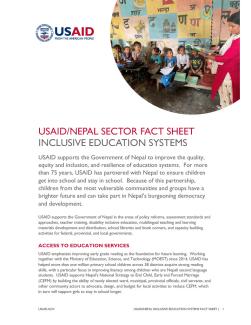Education Office Sector Fact Sheet
$26 Million in Current Activity Funding
USAID supports the Government of Nepal to improve the quality, equity and inclusion, and resilience of education systems. For more than 75 years, USAID has partnered with Nepal to ensure children get into school and stay in school. Because of this partnership, children from the most vulnerable communities and groups have a brighter future and are able to participate in Nepal’s burgeoning democracy and development.
USAID supports the Government of Nepal in the areas of policy reforms, assessment standards and approaches, teacher training, disability inclusive education, multilingual teaching and learning materials development and distribution, school libraries and book corners, and capacity building activities for federal, provincial, and local governments.
Access to Education Services
USAID emphasizes improving early grade reading as the foundation for future learning. Working together with the Ministry of Education, Science, and Technology (MOEST) since 2014, USAID has helped more than 1 million primary school children across 38 districts acquire strong reading skills, with a particular focus in improving literacy among children who are Nepali second language students. USAID supports Nepal’s National Strategy to End Child, Early and Forced Marriage (CEFM) by building the capacity of newly-elected ward, municipal, provincial officials, civil servants, and other community actors to advocate, design, and budget for local activities to reduce CEFM, which in turn will support girls to stay in school longer.
Education Systems Resilient to Shocks
USAID supports Nepal in restoring access to education for children disrupted by the 2015 earthquakes and, now, the COVID-19 pandemic and provides safe and relevant learning environments. USAID supported temporary learning spaces and school construction following the 2015 earthquakes, and continued this practice to mitigate the impacts of prolonged school closures due to the COVID-19 pandemic. USAID also developed teaching and learning materials that are publicly accessible through the online portal of the Center for Education and Human Resource Development, as well as mobile applications for students, teachers and parents.
Impact/Results:
USAID has developed more than 177 children's books in Nepali and established school libraries in nearly 10,000 schools.
USAID Developed 119 new digital learning lessons in the subjects of Nepali language, mathematics, science, social studies, and Nepali Sign Language, as well as lessons for children with dyslexia.
USAID has collaborated to support 1,600 children's books in 7 local languages.
USAID has trained nearly 25,000 teachers and school administrators on early grade reading best practices.
USAID has trained 396 out of the total 753 municipal local education units to use the education management information system to plan and budget for education interventions.
USAID has screened more than 23,967 students for functional limitations, developed an Integrated Educational Management Information System (IEMIS) sub-system to identify and track students with disabilities, and trained over 2,266 teachers on disability inclusive education.
USAID is supporting 6 municipalities with high rates of child marriage to plan and budget for activities to reduce child, early and forced marriage (CEFM).
USAID established more than 1,000 temporary learning centers and 250 transitional learning structures for over 93,000 students, and supported the construction of 27 earthquake resistant schools for more than 8,200 students.
USAID collaborated with the MOEST to develop a comprehensive school safety plan and trained teachers and communities to use data to make informed decisions on their reconstruction plans.
USAID has supported alternative education modalities in 1,421 schools of 61 municipalities in highly vulnerable communities to ensure out of school children have access to education.
USAID has supported the GoN to scale up access to digital and distance learning through the development of interactive digital learning activities for primary grades, and a sign language app.
*Data from FY2021
Share This Page



